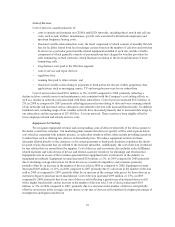Sprint - Nextel 2008 Annual Report Download - page 41
Download and view the complete annual report
Please find page 41 of the 2008 Sprint - Nextel annual report below. You can navigate through the pages in the report by either clicking on the pages listed below, or by using the keyword search tool below to find specific information within the annual report.Cost of Services
Cost of services consists primarily of:
‰costs to operate and maintain our CDMA and iDEN networks, including direct switch and cell site
costs, such as rent, utilities, maintenance, payroll costs associated with network employees and
spectrum frequency leasing costs;
‰fixed and variable interconnection costs, the fixed component of which consists of monthly flat-rate
fees for facilities leased from local exchange carriers based on the number of cell sites and switches
in service in a particular period and the related equipment installed at each site, and the variable
component of which generally consists of per-minute use fees charged by wireline providers for
calls terminating on their networks, which fluctuate in relation to the level and duration of those
terminating calls;
‰long distance costs paid to the Wireline segment;
‰costs to service and repair devices;
‰regulatory fees;
‰roaming fees paid to other carriers; and
‰fixed and variable costs relating to payments to third parties for the use of their proprietary data
applications, such as messaging, music, TV and navigation services by our subscribers.
Cost of services decreased $361 million, or 4%, in 2009 compared to 2008, primarily reflecting a
decline in labor, outside services and maintenance costs consistent with the Company’s cost cutting efforts, as
well as a decline in network costs associated with fewer subscribers. Cost of services increased $133 million, or
2%, in 2008 as compared to 2007 primarily reflecting increased costs relating to data and voice roaming outside
of our networks and increased service and repair costs related to devices with increased functionality. In addition,
backhaul costs, including usage of our wireline network, have increased primarily due to increased data usage by
our subscribers and the expansion of EV-DO Rev. A in our network. These costs have been slightly offset by
lower employee related and outside services costs.
Equipment Net Subsidy
We recognize equipment revenue and corresponding costs of devices when title of the device passes to
the dealer or end-user customer. Our marketing plans assume that devices typically will be sold at prices below
cost, which is consistent with industry practice, as subscriber retention efforts often include providing incentives
to subscribers such as offering new devices at discounted prices. We reduce equipment revenue for these
discounts offered directly to the customer, or for certain payments to third-party dealers to reimburse the dealer
for point of sale discounts that are offered to the end-user subscriber. Additionally, the cost of devices is reduced
by any rebates that are earned from the supplier. Cost of devices and accessories also includes order fulfillment
related expenses and write-downs of device and related accessory inventory for shrinkage and obsolescence.
Equipment costs in excess of the revenues generated from equipment sales is referred to in the industry as
equipment net subsidy. Equipment revenue decreased $38 million, or 2%, in 2009 compared to 2008 primarily
due to declining average sales prices for those devices as a result of competitive and economic pressures,
partially offset by an increase in the number of devices sold in 2009 as compared to 2008. Equipment revenue
decreased $603 million, or 23%, in 2008 compared to 2007 primarily due to a decrease in the number of devices
sold in 2008 as compared to 2007, partially offset by an increase in the average sales prices for those devices as
customers began to purchase more smartphones. Cost of devices increased $699 million, or 15%, in 2009
compared to 2008, primarily due to our mix of devices sold reflecting a greater mix of post-paid devices sold
with a higher functionality and an increase in the number of devices sold. Cost of devices decreased $165
million, or 3%, in 2008 compared to 2007, primarily due to a decrease in the number of devices sold partially
offset by an increase in the average cost per device as our mix of devices sold consisted of a higher percentage of
smartphones and higher-end devices.
39
























